The health problems of rural areas are alarming and increasing: consider the loss of clinicians, populations increasingly dominated by older people with chronic conditions, a high incidence of substance abuse, depression caused by isolation, and more. Now add to that the closures of pharmacies. It’s just getting too difficult to keep an independent, rural drug store staffed and financially afloat. So more and more people have to drive for several hours for something as routine as an antibiotic for strep throat—let alone a flu or COVID-19 shot.
I spoke to two company CEO/cofounders with knowledge in this area and interesting perspectives to contribute: Cary Breese of NowRX and Baha Zeidan of Azalea Health.
Have you considered how the 90 pills you get in your bottle were apportioned? Traditional pharmacies count them by hand. Yes, thousands of pills each week, counted one by one by highly-trained people.
And that makes sense, because every medicine has a different size and shape, in order to reduce the risk of error. But the simple process of filling a bottle with pills or capsules adds substantially to the cost of medication.
The big online pharmacies—Express Scripts, Caremark, etc.—have the scale to automate medication fulfillment. What’s special about NowRx’s robot-driven fulfillment systems (Figure 1) is that they have opened outlets in many cities and promise same-day delivery. Breese told me that their costs are less than half those of traditional pharmacies and are declining. Besides the cost savings (and the elimination of mind-numbing tedium), automated fulfillment allows more people to get medicine delivered to them, which Breese says increases compliance.

Unfortunately, the NowRx model isn’t yet feasible outside of metropolitan centers. Robotic deliveries, and perhaps eventually UAVs (drones), in combination with kiosks and telepharmacy solutions, might make rural deliveries cost-effective and a reality in the not-so-distant future.
Meanwhile, what can we do to save pharmacies?
Breese also offered a bit of history about pharmacies and their changing business models. Originally, pharmacists focused on getting to know their customers and providing advice that doctors might not have considered. The pharmacist is often the one to tell the patient whether to take the medication on an empty stomach, or to avoid certain over-the-counter drugs while taking the medication. To this day, Breese says, pharmacists are among the professionals most trusted by the public—more than physicians.
Then chains such as Rite Aid, CVS, and Walgreens—and later megacorporations such as Walmart—took over most of the pharmacies. These chains, according to Breese, try to keep profit margins thin and depend on people picking up a tube of toothpaste or a pack of cigarettes with their medication. (Of course, the major pharmacies finally realized that the sale of cigarettes was antithetical to their health missions, and took them off the shelves.)
The growth of online pharmacies then eviscerated the local stores, just as Amazon. No wonder CVS is rapidly closing stores. Like other pharmacies, they are broadening their business models to be more like wellness centers.
Rural pharmacies still face daunting challenges. Zeidan suggests another way to save them: authorize more services for pharmacists. After all, they can give us vaccinations. It’s the ability of pharmacists to put a needle in our arms that has allowed the U.S. to manage the toll taken by the annual flu, and now COVID-19.
Why not let pharmacists prescribe birth control medication? They can already do so in California. Both Zeidan and Breese think that many more functions could be performed safely and cost-effectively by pharmacists, but are currently restricted to doctors because of regulations that doctors’ trade associations have pushed.
Even though online fulfillment centers do a great job, everybody is entitled to fast, local medication in urgent situations. A combination of technology and ways to expand the roles of pharmacists could very well preserve this honored tradition.













